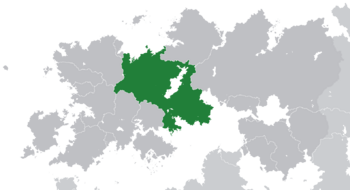Tervingia
This article is incomplete because it is pending further input from participants, or it is a work-in-progress by one author. Please comment on this article's talk page to share your input, comments and questions. Note: To contribute to this article, you may need to seek help from the author(s) of this page. |
Tervingian High Kingdom
| |||||||||||||||
|---|---|---|---|---|---|---|---|---|---|---|---|---|---|---|---|
| 323 BCE–429 CE | |||||||||||||||
 Largest extent of Tervingia, c. 220 CE | |||||||||||||||
| Status | Dissolved | ||||||||||||||
| Capital | Saragetra | ||||||||||||||
| Religion |
| ||||||||||||||
| Demonym(s) | Tervingian, Gothic | ||||||||||||||
| Government | Empire | ||||||||||||||
| History | |||||||||||||||
• Established | 323 BCE | ||||||||||||||
• Dissolution | 429 CE | ||||||||||||||
| |||||||||||||||
Tervingia was a major Gothic political state and cultural power in eastern Belisaria which existed from 323 BCE to its dissolution in 429 CE.
Origin
The general Lake Kupalnitsa area had long been inhabited by a diverse group of ancient tribes and proto-civilizations, with the north of the lake and the Karmin river delta having been home to proto-Germanic and later Gothic tribes and petty kingdoms united nominally by their paganistic religion and basic structure of their governments. By 400 BCE, the primary focal point of sociocultural and economic power in the region was the northern Gothic petty kingdom and city of Saragetra, located near the modern Ostrozavan city of Trebor. Under the successive leadership of multiple petty kings, Saragetra's nascent political structures, which were increasingly centralizing, expanded over the northern edge of the Lake and into modern day Drevstran, where they further assimilated the Gothic peoples of the Azdrheg lowlands, though the more southern people of the Azdrheg highlands resisted attempts of direct subjugation, instead adopting a policy of harrasment and asymmetric attacks that ultimately halted any further expansion by Saragetra.
The semi-legendary figure, Lorelei Saratheoda, was the the first female queen of the petty Kingdom of Saragetra, and is commonly attested in both regional folklore and contemporaneous accounts by figures in the Latin Empire as the first to consider a pact of equality between different tribes in response to aggressive encounters with both organized and disciplined forces of the empire in the West, as well as Nordic raiders on the major waterways of Gothic lands and increasingly bold Cyneric raiders, which had been harrassing the northern reaches of Saragetran territory for over a century.
Thus, Queen Lorelei called the First þiudaþing between rulers in the region in 339 BCE, establishing formal diplomatic relations with Valeni, North Germanic, and remaining Gothic polities in the region; many of these peoples agreed to pay tribute to the central Saragetran kingdom in exchange for military protection, thus beginning the political structure of decentralized rule that would lead to a stronger Tervingian government later.
As a beginning of eventual greater centralizaiton of the þiudaþing Pact, Lorelei also managed within two years of the event to secure the more entrenched allegiance of Valeni tribes throughout the Balrog river valley though personal marraige of her son, Alica, to the eldest daughter of a prime Valeni chieftan, in 327 BCE. By popular tradition, the Prince woke the chieftain's daughter from an eternal slumber placed upon her by the trickster god, Duda, and subsequently married her during Yule celebrations.
Height
As more stories of a "great army of conquerors" began to disseminate into the Lake Kupalnitsa area, centralization of the Pact seemed to have accelerated, culminating in 323 BCE with the second þiudaþing and the declaration of the Waipsmahts Kunjahaidus Tervingiuta, or "Crown and Customs of the Tervingians". This is considered to be one of the first recorded legal documents in the area, the first mention of the name Tervingia, and the first workable constitution of a nation of peoples in Belisarian history.
